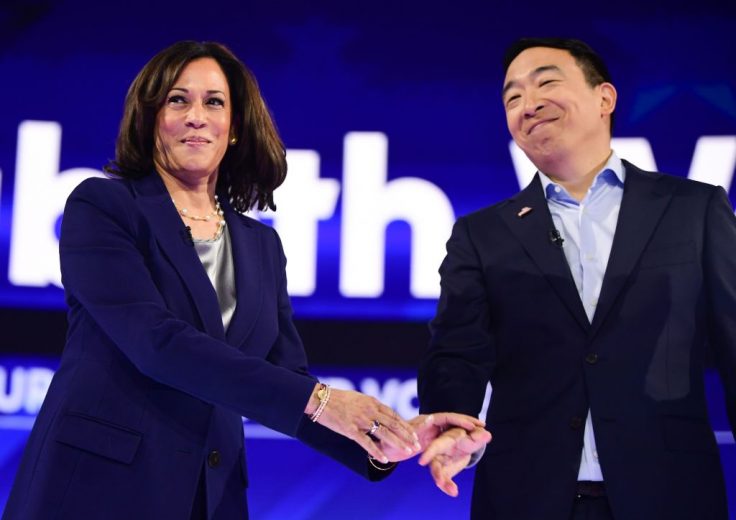
For every Kamala Harris, there’s an Andrew Yang round the corner

The nomination of Kamala Harris, an American of partly-Indian origin, as the Democratic candidate for the post of United States vice-president could be considered an apogee in terms of immigrant achievement. Actually winning the election would be an ethnic-gender watershed in US history, but one has to wait until November to find out.
In the meantime, given the neighbourly “keeping up with the Joneses”-type rivalry that exists between India and China, it would be of vicarious interest to see how far Chinese Americans have reached in the US stakes and whether Kamala, if elected, will have put one past our neighbour.
Chinese Americans lead Asian immigrants in numbers. According to the 2018 American Community Survey (ACS) data, there were 2.84 million Chinese Americans to 2.65 million Indian Americans.
In politics too their rise has been almost on par with Indian Americans until Kamala Harris (has possibly) pipped Andrew Yang to the post. A Chinese American politician, Yang contested in the 2020 race for the Democratic presidential nomination.
Son of immigrants from the Chinese-breakaway island-state of Taiwan, Yang was considered a surprise candidate for president from the Democratic party. He gave a good fight, figuring in at least seven presidential debates. Media reports characterised him as a “happy go lucky” individual and he managed to get widespread endorsements for his candidature. He eventually withdrew from the race and became a media commentator but indications are he will surface again in the coming years, targeting the top job.
For every Sunder Pichai (of Google) there is an Eric Yuan (founder of Zoom Communications, that has become a global buzzword in this period of the COVID-19 lockdown).
Related News: Kamala Harris to hit out at Donald Trump in her VP acceptance speech
California, for instance, has the maximum number of Chinese Americans as also Indian Americans.
Charles B Wang, as co-founder and CEO of CA Technologies, is among the top honchos in the IT sector. Among the workforce, the Chinese and the Indian Americans share the honours. As a report quoting the CTO of Accord Interest says, “80 per cent of the company’s team members are made up of either Indians or Chinese”.
According to some estimates, in top companies like Google, Cisco and Apple besides Twitter and Facebook, the minimum number of Chinese is at least 10 per cent of the workforce.
If there is Hargobind Khurana, the first of an Indian-origin Nobel prize winner for his work on molecular biology, there is Charles Kuen Kao for the Chinese, the winner of the Nobel Prize for Physics in 2009. Another Nobel winner of Chinese origin was Samuel Chao Chung Ting, again for Physics, much earlier in the 1970s.
The Chinese, akin to Indians like Nikki Hailey, have had top officials in successive US administrations – Gary Locke, for instance, was the United States Secretary of Commerce in the Obama dispensation.
Interestingly, as Indians, we would like to sift through US records to see who has done what. But, within the US, both are considered Asian. And, more often than not, all of Asia is lumped together as one category unless there is a reason to delve deeper into specifics on who belongs where.
Related News: Kamala Harris appoints Indian-American Sabrina Singh as her Press Secretary
As some Indian-Americans point out, there is an underlying sense of competition between Indian and Chinese immigrants. But, it is generally not overt. Practically speaking, each community acts independent of the other and would rather prefer to ignore each other than openly tune up their rivalry, if it does exist.
Among the areas that Indians clearly dominate is in the English Spelling Bee competition, especially in the last two decades. Since 1999, there have been 26 Indian winners. In the 2019 championship, of the eight co-winners, seven were Indian-Americans.
As for the Chinese, the big setback is the slow start to English back in China, a historical disadvantage that precludes them from reaching the top globally where the language is concerned. But it is a matter of time. With English language teaching in China being given a huge leg up in recent years, it may be a matter of time before they jostle with Indians for a share of their sun in this competition.
A three-decade-old lobby group of Chinese Americans, the “Committee of 100” is an influential lobby in the fields of government, academia, culture and business. It attempts to be a neutral body that pushes Chinese interests in the US and vice versa, with some credit for much of the expansion in trade ties between the two countries.
Not to be left behind are Indian lobby groups like the Indian American Forum for Political Education which are active and mainly focus on countering Pakistani lobbies in the US rather than competing with the Chinese.
Related News: ‘In Madras, I would…’: Kamala Harris takes trip down memory lane
One area where the Chinese score hands down in the US is their cuisine. According to a Google survey the Chinese come number one with a popularity score of 64 while Indian cuisine comes a distant fifth with a popularity score of 11. In another survey by the Voice of America, 76 per cent of Americans prefer Chinese cuisine (which is number one on the list) while Indians figure at 19 per cent, which is ninth on the list.
In effect, it is a mixed bag with immigrants of both countries having something to crow about. Most of them have at least one foot firmly affixed in their native countries seeking to leverage their achievements in the US and turn into something of a legend. If it is Kamala Harris today, it could well be an Andrew Yang tomorrow.

